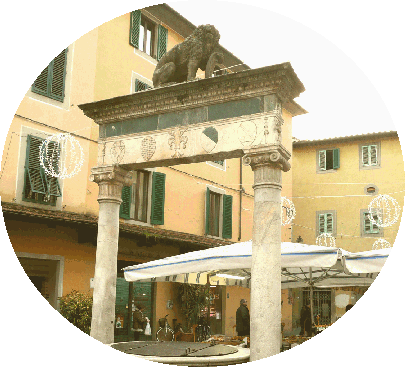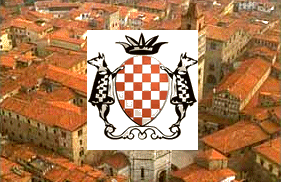|
|
DISCOVERING
PISTOIA
PIAZZA DELLA
SALA
 This
was once the location of the steward’s palace – the royal representative
of the Longobards in the 8th century. Since the Middle Ages a food
market has been held in the square, at the centre of which stands the
“Leoncino” well, donated to the city by the Medici in 1451.The Sala, as
it is commonly referred to in Pistoia, is one of the city's oldest
squares. lts name comes from the Lombard word for the building where the
public administration was located and, in fact, this was the site of the
viceroy's house during Lombard rule. No trace of this prominent building
has survived today but the site's importance is recalled in the name of
the Baptistery which has always been referred in as in Corte
because of its location near the curtis domini regis. The street that
linked the Sala to the gate of Porta San Pietro (today the via di
Stracceria and the via della Torre) was called the via regis. With the
construction of the Palazzo degli Anziani in the Communal period the
center of city life shifted back to the piazza del Duomo and the Sala
became the center for free trade and commerce that it is today. A
market, mostly selling food products, evolved and artisans established
their workshops here. The memory of these different activities still
survives in the names of the nearby streets and squares: via del Cacio,
sdrucciolo dei Cipollini, via dei Fabbri, via degli Orafi,
via del Lastrone (which takes its name from the large stone on
which fish was sold) and the piazza degli Ortaggi (which today hosts the
sculpture Giro del Sole by the Pistoian artist Roberto Barni). This
was once the location of the steward’s palace – the royal representative
of the Longobards in the 8th century. Since the Middle Ages a food
market has been held in the square, at the centre of which stands the
“Leoncino” well, donated to the city by the Medici in 1451.The Sala, as
it is commonly referred to in Pistoia, is one of the city's oldest
squares. lts name comes from the Lombard word for the building where the
public administration was located and, in fact, this was the site of the
viceroy's house during Lombard rule. No trace of this prominent building
has survived today but the site's importance is recalled in the name of
the Baptistery which has always been referred in as in Corte
because of its location near the curtis domini regis. The street that
linked the Sala to the gate of Porta San Pietro (today the via di
Stracceria and the via della Torre) was called the via regis. With the
construction of the Palazzo degli Anziani in the Communal period the
center of city life shifted back to the piazza del Duomo and the Sala
became the center for free trade and commerce that it is today. A
market, mostly selling food products, evolved and artisans established
their workshops here. The memory of these different activities still
survives in the names of the nearby streets and squares: via del Cacio,
sdrucciolo dei Cipollini, via dei Fabbri, via degli Orafi,
via del Lastrone (which takes its name from the large stone on
which fish was sold) and the piazza degli Ortaggi (which today hosts the
sculpture Giro del Sole by the Pistoian artist Roberto Barni).
Back to previous
page

PISTOIA
PHOTOGALLERY
PISTOIA CITY MAP
|